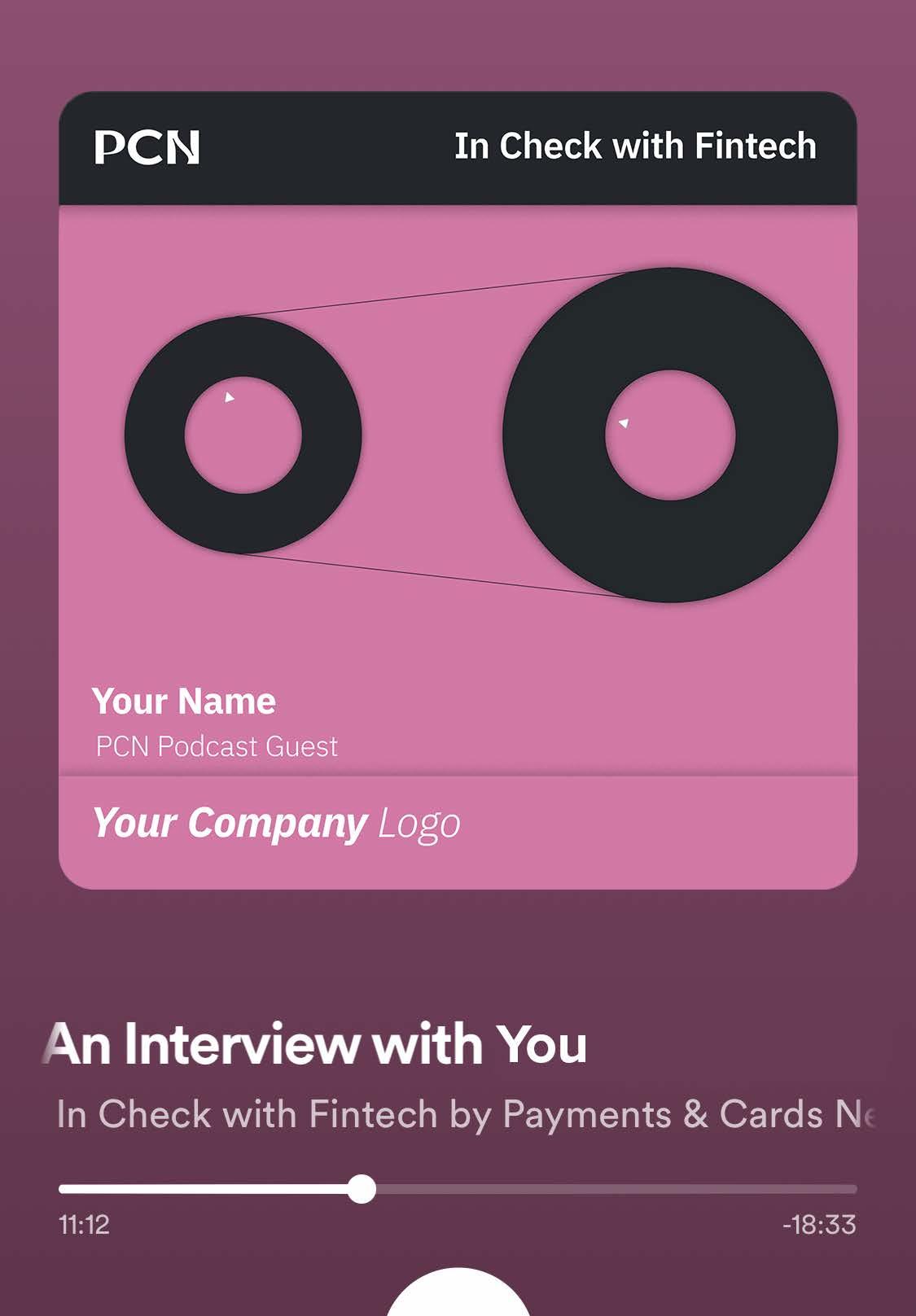
22 minute read
The Financial revolution
C D

Advertisement
Lex Sokolin
Global Fintech Co-Head and CMO of ConsenSys
Lex is a futurist and entrepreneur focused on the next generation of financial services. He is the Global Fintech CoHead and CMO at ConsenSys, a blockchain software company building the infrastructure, applications, and practices that enable a decentralized world. He focuses on strategy and product development across Fintech, Decentralized Finance and DAOs, public and private enterprise blockchain solutions, and emerging crypto asset classes. Previously, Lex was the Global Director of Fintech Strategy at Autonomous Research, an equity research firm serving institutional investors (acquired by AllianceBernstein), where he covered artificial intelligence, blockchain, neobanks, digital lenders, roboadvisors, paytech and mixed reality. Before Autonomous, Lex was COO at AdvisorEngine, a digital wealth management technology platform (acquired by Franklin Templeton), and CEO of NestEgg Wealth, a roboadvisor that partnered with financial advisors. Prior to NestEgg, Lex held roles in investment management and banking at Barclays, Lehman Brothers, and Deutsche Bank. He earned a JD/MBA from Columbia University and a B.A. in Economics and Law from Amherst College. Lex’s thought leadership has appeared in the Wall Street Journal, Economist, Bloomberg, FT, Reuters, American Banker, ThinkAdvisor, and Investment News, among others. He is a regular speaker at industry conferences such as Money2020, LendIt, Schwab Impact, In|Vest, T3 Enterprise Edition, and Consensus. His writing is publicly available at lex.substack.com.
ConsenSys is the leading Ethereum software company who enable developers, enterprises, and people worldwide to build next-generation applications, launch modern financial infrastructure, and access the decentralized web.

Financial Revolution spurred on by Decentralized Finance
Decentralized finance has grown into one of the most active sectors of blockchain, now with over $15 billion total value locked in DeFi smart contracts. From decentralized exchanges to lending and insurance platforms, the DeFi ecosystem is flourishing and unlocking a modern financial infrastructure that is setting new standards for access, resilience, and transparency.
DeFi makes it possible to reproduce the instruments and certain mechanisms of classic finance in a decentralized environment like that of Ethereum. What has emerged is a vast spectrum of activity: on one end, there are open finance platforms that empower individuals around the world to engage with new and remodeled financial systems. And on the other, decentralized finance solutions are transforming the approach of traditional institutions. We see a growing number of use cases that mainly address the custodial character of finance. There is particular interest in DeFi solutions in countries without a solid financial infrastructure. Decentralized applications, also called dApps, have emerged in recent years. Using dApps, it is possible for anyone, regardless of their economic and geographic situation, to access DeFi solutions by connecting to a compatible wallet, such as MetaMask, on their mobile phone. All in all, decentralized finance projects now range in the thousands, and we’re witnessing the emergence of a whole new, global infrastructure for financial activity.
M&A in Decentralized Finance There is a discussion of mergers and acquisitions in decentralized finance. We find the whole thing fascinating. An analysis of the issues can help us sharpen a toolkit for understanding value creation and power in a world of open source, programmable blockchains and their assets. It can help us understand why things like “number of blockchain patents” are nonsense, and therefore suggest to financial incumbents a better way to be. The last time we had a corporate development discussion about tokens was in 2018 with Messari. Ryan’s view at the time was that a number of low quality projects sold their ICO tokens and received Ether (ETH). So let’s say you sold 10 million of X, and got $10 million of USD equivalent denominated in ETH. As the market realized your project was worthless, let’s say X falls 90% in value. But the treasury still holds $10 million denominated in ETH! So the vulture fund strategy, copying a page from the book of 1980s traders and leveraged buy-out professionals, would be to buy up all the worthless X and somehow get control of the treasury. You pay $1 million USD equivalent for $10 million in treasury assets and profit. This didn’t work for a few reasons. First, ICO tokens did not have meaningful governance rights, or any enforcement mechanisms. If you buy them all, the only thing you hold is a bunch of digital pets. Yes, you could argue “reliance” to a court and extract damages or file injunctions. But it is highly unlikely that would find suitable jurisdiction, and by the time you get it done, the house will have burned down. And second, ETH fell from over $1,000 to nearly $100. So the value of the honeypots became irrelevant. Today in 2020, we no longer have ICOs, but we do have decentralized finance. And in the last 6 months, governance tokens over decentralized autonomous organizations (DAO) have become the standard playbook. Let’s unpack that. If you buy a container that gives you economic rewards based on the efforts of others, you are very likely buying a security. If that security is sold to you in a way that is not pursuant to securities laws of your resident jurisdiction, there’s a large liability on the issuer. There have been some signs from regulators, however, that a token changes nature over the course of its lifecycle. It may add securities-like features, while starting out as an empty container. It may be at first motivated by usage (i.e., like a reward) and then become a participant in cash flow. The biggest lifeline came in 2018, when William Hinman introduced a concept of “sufficient decentralization”, per below. While far from gospel, many crypto entrepreneurs now believe that turning a protocol / project into a DAO gets the project over the safe line from securities registration. Time will tell whether relying on an SEC speech is valid defense. It also helps that issuing governance tokens for a DAO creates market capitalizations and enterprise value for token holders. The main DeFi players of 2020 each have $100+ million or more in the market cap of their instantiated tokens. This has accrued from various distribution mechanisms that embedded financial assets as rewards for financial use. As an example, if you deposit your tokens for others to borrow in one venue, you get rewards at some interest rate from the borrower.

To read through the obvious from the Messari data, Uniswap and Aave are at $900 million, Yearn at $800 million, Maker at $560 million, Synthetix at $530 million, Compound at $470 million, Balancer at $100 million, and Curve at $95 million. These numbers may change or go to zero. But currently, there is about $3.5 billion of enterprise value associated with the governance tokens of decentralized finance projects. Certainly there are many other projects that are key to this space. But the above are the main DeFi machines in operation. $4.5 billion is a chunk of change. Envestnet is trading at $4 billion, Jack Henry at $12 billion, Temenos at $8 billion, Broadridge at $12 billion. These are your industry comparisons. When a large corporate tech player decides to buy up a competitor, the process is clear and well established. Generally, shareholders elect the board of directors, which governs the company and appoints executive management. Shareholders also vote for large, existential transactions that impact their stock holdings. The Board applies business judgment to the corporate development path of the company, from issuing debt, to buying back shares, to investing in acquisitions. Within the company, executives focused on corporate development will hunt down targets and propose various transactions. Everyone knows what it means to maximize shareholder value, which largely boils down to maximizing EBITDA at some multiple in the market, without creating onerous debt. But what about open source financial protocols?
Decentralized M&A
Yearn is likely the most sophisticated financial DAO in existence. Whereas Compound & Aave match margin lend/borrow demand at particular interest rates, and Uniswap & Balancer & Curve create automated market making for on-chain trading, Yearn is a blockchain-native fixed income active asset manager. For 2020 at least, Yearn is the Bill Gross of crypto, playing across trading fees, interest maximization, dividend farming, governance rewards, and various other technological innovations that lead to capital appreciation. The “funds” are called “vaults” or “pools” or “jars” and so on. They are just the equivalent of SMAs or fund interests, synthetically structured through code. The interesting thing is that the whole thing is open source, so in principle, somebody could just copy the code base. And somebody did! The fork is called Pickle Finance, and had between $100 and $400 million in assets. During the summer run-up of the DeFi markets, forks generated trading returns by simply existing. However, over the long term, it is much more difficult to retain a community and assets. It is hard to maintain a thing that works in the highly adversarial DeFi environment, where protocols are under constant attack. A recent $20 million exploit left Pickle ... in a pickle. The recent news is that Pickle is going to be “merging” with Yearn. Given that the technical architecture is quite similar, and the experience of the developers is comparable, the core part of the merger is onboarding Pickle developers to work on Yearn. This implies that the Pickle protocol converges its path and community back to Yearn, and that Pickle-specific features will be an addition to, rather than a differentiator against, Yearn. Deeper DAO related features will also be implemented based on a design from the Curve DAO. Holders can tweak the tokenomics of the machine in real time to create incentives in different dimensions (e.g., more issuance of rewards here, less here).
This merger is not about the technology. It’s about the people writing code to create the technology. And who pays them what. If the incentives from Yearn cash flows are much higher than the incentives from Pickle cash flows, a lagging protocol can’t last long in an adversarial environment. Attackers prefer to go after those who have the least defense, not those who are most capitalized. There is a fixed cost to defense, which creates competitive barriers and winner-take-all outcomes. And in a world where capital can move without friction between investment venues, a merger will also pull that community to follow you to the new protocol. Notably, the governance tokens for Yearn had limited input on this “transaction” -- in part because governance is not clearly, legally articulated, and in part because the transaction did not involve the sale and purchase of assets. The assets are open sourced, and people have the freedom and ability to switch what they decide to work on. Not only is capital movement much less restricted, but so is the stickiness of “employees”. Another announcement quickly followed. Yearn is “merging” with Cream, a fork of Compound and Balancer, making it a combination of lending markets and an automated market maker. In this case, however, it seems that Yearn is delegating to Cream several strategic product developments, like leverage and a pool-agnostic (i.e., collateral agnostic) stablecoin. In traditional finance, we would call this a cash sweep account. The developer teams, again, are merging together. We assume the benefit to Cream is in part driven the lower the costs of potential errors, in addition to higher cash flow. And another. Yearn and Akropolis. The latter had a $2 million hack earlier in the month, and going forward will play the role of institutional distributor of Yearn products, as well as be part of investment strategy formulation. The same compensatory mechanism of issuing tokens to Pickle holders (i.e., a piece of something that looks like debt) will be applied to Akropolis holders. So what do we observe? Yearn is extending not just its technology, but its economics and reputation to “bail out” multiple projects that have great teams but have all suffered in the recent past. In a world where financial instruments are manufactured by machines on open source rails, it is not the rails that are valuable. Yes, over time, the rails become more sophisticated and are stress-tested by capital and hacking. But what actually holds “value” are (1) the communities that commit assets to protocols, and choose to align economic activity with some particular brand, and (2) the entrepreneurs that have the very rare skill-set of building and securing such protocols. The community is the business asset. It generates cash flow. It improves governance. It fixes hacks. Notably, communities align to brand narratives and the celebrities and influencers that spearhead the narrative. Andre will represent Yearn, despite decentralizing maximally his project, is the face of the fund. Popular confidence in his good will and judgment is the measure of the project. Similarly, confidence in Vitalik Buterin is correlated with confidence in Ethereum. There is something deeply conservative in the realization that these futuristic finance networks rely on philosopher kings and have increasing returns to scale. But this was always the case. Humans need torch-bearers. Steve Jobs, Elon Musk, and the rest. In the case of DeFi, the torch itself is of a different kind. But it burns with the same flame.
Central Banks and The Future of Digital Money
The rise of cryptocurrencies and blockchain technology over the last decade has brought about new possibilities in the issuance and use of money as well as exciting new forms of digital assets and markets. At the same time a rapidly evolving geopolitical, economic and social environment has created new expectations and new requirements for secure, reliable, easy-touse, globally available digital payments and means of exchange.
Among the most significant innovations we are witnessing today are stablecoins, or privately issued cryptocurrencies pegged to a stable asset, which today have a market cap over $20B USD, as well as the parallel phenomenon of central bank-issued digital currencies, commonly referred to as CBDC.
According to the Bank of International Settlements, over 70% of central banks are looking at issuing a digital currency on a blockchain. We think this is a development to be applauded.
CBDCs can offer a range of advantages. They can play a central role in advancing the digital assets revolution in a regulated, lower-risk and – crucially – accessible way, helping make financial markets more efficient and available to all global citizens. CBDC can give the central banks more effective, future-oriented tools to allow them to implement monetary policy in more direct and innovative ways and keep pace with technological change. CBDCs could also simplify and reduce the cost of cross-border remittances, while forming the basis for more efficient, more secure interbank payments networks.
We believe that Ethereum is the best-suited blockchain network for the kind of maximally secure, global-scale, interoperable settlement platforms that CBDCs require. But there are many other possibilities.
Over the past year we have seen a number of announcements from central banks around the world exploring the issuance of central bank digital currencies (CBDC). Blockchain-based CBDC, which represents a new technology for the issuance of central bank money at the wholesale and retail level, offers a number of potential advantages for central banks. It could be a strong catalyst for financial services innovation by providing a viable, large-scale payments system for tokenized assets markets – offering a risk-free, widely accessible alternative to privatelyissued stablecoins, like Facebook’s Libra, which serve a similar purpose but could expose users to credit and/or liquidity risk.
Widespread use of CBDC instead of private payment tokens could also help central banks retain sovereignty over monetary policy in tokenized assets markets, an important consideration should such markets come to represent significant portions of the economy. Other benefits include potentially new regulatory monitoring and enforcement tools, cheaper crossborder remittances, improvements to the interbank payments infrastructure and innovation in retail markets. CBDC could also be a superior replacement to physical cash, helping alleviate some of the risks and costs associated with banknotes.
Depending on how it is designed, a CBDC could support financial inclusion by providing wide-scale access to risk-free reserves.
ConsenSys has been on a tear recently announcing 4 different CBDC projects on Ethereum infrastructure. Let’s briefly highlight those:

• Bank of Thailand to use enterprise Ethereum for retail CBDC prototype with ConsenSys • Australia’s central bank announces CBDC project with ConsenSys • Societe Generale selects ConsenSys for CBDC experiments • ConsenSys wins Hong Kong central bank digital currency project

The discussion of CBDCs is often a stark reaction to the development of Facebook’s Libra private stablecoin / USD network, and the Chinese deployment and expansion of their national digital currency. The discussion often splits into (1) wholesale CBDCs, which largely reinforce and optimize the role of banking institutions relative to the central bank’s money management authority, (2) retail CBDCs, which would bypass the banks and go directly into the wallets of consumers. The first option is about efficiency and industry cost mutualization. The second is more deeply transformative, and analogizes more closely to owning Bitcoin and using it to transact. In many of the projects above, there is a combination of a financial institution, a technology consulting firm, and a blockchain company coming together. ConsenSys brings forward enterprise Ethereum, which is a variant of the open source programmable blockchain optimized for a permissioned deployment with large transaction throughput. Unlike public Ethereum, which just launched the first phase of its scalability upgrade (Eth2), private permissioned networks scale more easily because you do not start with an open adversarial environment. Other examples of such enterprise networks would be IBM and Hyperledger Fabric, or R3 and its Corda technology, as the chassis for digital value transfer and settlement.
How should we contextualize Ethereum-based CBDCs relative to Bitcoin, Visa, and PayPal? First, there is the actual network itself. Much of the current thinking is about the software protocol as the ledger. Where does the information actually live? Who hosts it? Who processes it? In the previous world, data centers and servers run by some firm (e.g., Visa or a cloud-provider like Google / AWS) hold a copy of the information and run software which performs computation about the transactions. In the current world, the blockchain is itself a set of some large number of duplicates of the data set, held by each of the network participants. In the case of programmable blockchains, those network participants are also each executing software programs, which are then synced across the entire system. Making sure this network functions and reflects the requirements of a central bank, or other constituents, is a key part of standing up a CBDC. This is, we think, what most industry participants are really thinking about. Read the whitepaper from ConsenSys to learn more.
Alternate: Fintech to DeFi
The last decade has seen a Fintech boom unlike anything in the industry’s history. Financial start-ups grew from a footnote in venture capital (at around 5% of total), to the fair share of GDP at over 15%. Private capital doubled, and then doubled again. As a result, Fintech vertical champions sprouted like mushrooms across payments, banking, lending, investments, and insurance. As you well know, they are converging into the same financial super-apps that we see in the East, with competition from financial incumbents and tech companies driving pricing down 50% or more. Squint, and everyone looks the same. But nothing feels fundamentally different. Yes, we have some new brands that live on our phones. But when sliced across deposits, volume, or assets under management, the public companies still do the lion’s share of the financial work. With open banking, incumbents are likely to win even more, powering Apple’s credit card for example. The core reason for this, I think, is that Fintech has democratized access to existing financial products. It has not really changed how those products are manufactured. Only by transforming how things are made and the value chains to deliver them can you build the Google, Netflix, Spotify, or Uber of the next generation. Blockchains are good for building financial products -- whether powering core banking, turnkey asset management, payments processing, or financial instruments themselves. They come with so many native features out of the box that the industry should love, from deep audit, to native reconciliation, to programmability and cyber-security. And yet, it’s been hard to get things really going at scale, despite the proof. Since 2015, Ethereum developers have routed payments, helped people save money, created investment vehicles, built lending and insurance machines, and still we are sceptical! At the very beginning, the starting point is for companies and operators to agree on shared data standards. For organizations that have spent centuries thinking about how to compete against each other, letting go of even back-office costs is difficult. Yet there is no competitive advantage in making industries less efficient by creating information friction – something that has become absurd in the land of data science and emerging artificial intelligence. Once industries, whether in supply chain finance, banking and payments, or capital markets, agree on shared data standards, the next step is to mutualize certain workflows that derive from the data itself. Examples include standard software procedures for negotiating legal documents and the terms of financial instruments, or reconciliation and settlement of securities trading. We have seen meaningful digital transformation benefits from these efforts, lowering operating costs, speeding up arcane human processes, and generally improving the customer experience. For this digitization, look to enterprise blockchains, like private deployments of Ethereum with built-in privacy, permissioning, and scalability. And yet, embedded industry rule-sets and shared software functions are still at the early stages of what this technology can accomplish. Once companies are sharing data and performing common workflows, there needs to be a substantive object to which the software applies. Tokenization is the next step in the DLT maturity curve. We can turn any piece of captured data into a token, secured by world-class cryptography and thereby creating a digital asset. Such digital assets can represent any number of real world financial and commercial instruments, from currencies, to securities, bonds, commodities, real estate, or physical goods. They can also be extended to more speculative units of value, like human attention, medical data, or corporate identity. In the beginning, these tokens capture a very small percentage of information about the outside world, like a hyperlink that points you to a PDF of a printed book. Over time, we see deeper functionality being embedded into these digital assets, and into the networks on which they travel. When looking at financial services for example, smart programmable financial instruments begin to emerge. Bonds will have software covenants that are triggered automatically by data events. Equities will issue their own dividends and split automatically in an investment accounts. Commodities will have digital twins and equilibrate in price. Increasingly, the software that used to effect real-world assets will begin to have a digital analog, and be part of the digital assets themselves.
One day, all such software may live in distributed networks, hosted and powered by the companies within particular sectors and industries. Their products will be rigorously permissioned and tracked, flowing through digital versions of today’s value chains. New types of markets and networks will emerge to enable this interconnected, global commercial web. The same underlying software rails could be used across commerce, payments, banking, lending, and insurance. Just like we use the Internet today to see our bank account web apps, trade stocks, or e-sign legal agreements, we will use blockchain-based Web 3.0 to transact, maintain, and engage with digital commerce and finance. This is called Decentralized Finance. One of the most compelling attributes of the movement is its anchoring in a community of users and investors that has self-bootstrapped a new financial system. It is unabashedly part of the Internet. Whereas Fintech is a bridge -- trying to digitize and reformat old finance into a digital one -- DeFi is a new beginning. It is made for the Internet, from the Internet, by the Internet. Its logic is open source, its history is Napster, and it spreads like a software virus. Stop thinking about the asset, and start thinking about its gears and engines. Ethereum is where the experiment is already happening. There are 120 million unique addresses (i.e., accounts), over 3 million smart contract calls per day (i.e., a request to/from a software). Over $15 billion of capital is being used as collateral -- “locked” in the parlance of the industry -- to power new financial machines. Digital currency is collateralized, invested across lending products, and then sent to multiple trading and derivative exchanges on the left. There is growth in the number of services providers, their specialization, and their users. There is also growth in the connection between these services, and the economic activity between them. As more activity from real world economies is able to shift to public blockchains, this is the seed from which the modern financial factory emerges. The stunning thing about the DeFi offerings is not just that they are targeting a large financial technology use-case. Of course they are! Human nature does not change. Rather, it is that they target these use-cases while running on a common software infrastructure, being interoperable, and open source. We are a stone’s throw away from the global financial industry running on a common software infrastructure across asset classes, being natively interoperable, and open source. Sounds good to me!



Do you want to be our podcast guest and share your fintech story to 10,000 listeners?







